Tips for spotting fake sourdough bread at the store so you don’t waste your money on a phony product that is an unhealthy choice.
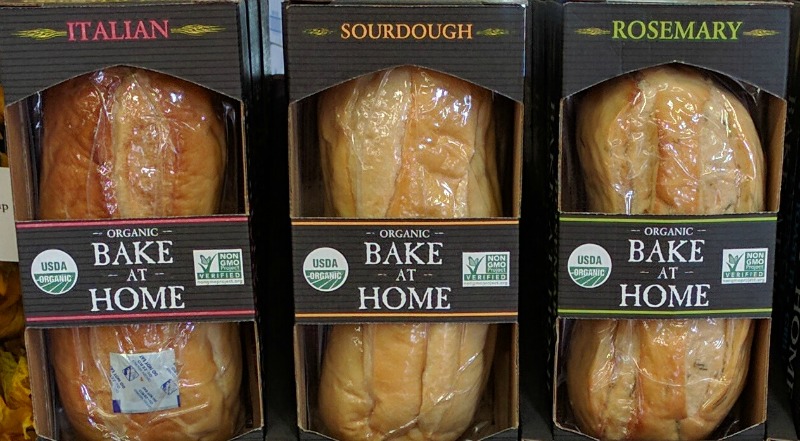
As awareness of the benefits of sourdough bread increases, so does the potential for food manufacturers – both large and small – to exploit the term.
And exploit it they most certainly do!
I recently examined every single loaf of bread at a local health food store. I found only one out of over half a dozen that claimed to be “sourdough” that was leavened in a traditional manner. No, it wasn’t The Essential Baking Company sourdough bread in the picture above. You won’t believe what this company is doing to fool consumers. Even I was shocked, and I thought I had seen it all.
If you choose to buy instead of making sourdough bread yourself (yes, it is a bit time-consuming!), then be on the lookout for fake sourdough!
It is literally everywhere!
Spotting phony sourdough is a more difficult process than you might think due in part to the sourdough myths that seem to abound.
When I first set out to write this article, I thought it would be fairly straightforward to explain. As it turns out, spotting a fake sourdough is rather tricky due to unethical food manufacturer tactics that are far sneakier and devious than I ever imagined.
You really need to be on your toes when sourcing sourdough bread to ensure that you aren’t wasting your money on a product you thought was a healthy choice for your family, but in fact, was quite the opposite.
If you use reading glasses, be sure to always bring a pair with you into the store so you can read the fine print on the packaging. If you wait until you get home to take a look, chances are you are going to be disappointed.
Fake Sourdough Masquerading as Real
The picture above shows one of the most popular fake sourdoughs on the market as of this writing. I was asked to take a look at it by a reader who thought it was legit. This brand is available at many health food stores. At my local Whole Foods, it is very prominently placed with an attractive display right near the checkout lines.
Some folks have notified me that it is also available at Sam’s Club and Walmart mega-supermarkets too!
Notice how the company has taken great care to appeal in every way to the health-conscious, time-challenged consumers:
- The loaf is clearly labeled “Sourdough”.
- The USDA Organic certification is front and center on the box.
- The NonGMO Verified label is prominently shown.
- The term “Bake at Home” is used to catch the eye of time-strapped consumers, some of whom WANT to provide fresh-baked sourdough for their family, but just don’t have the time.
I give this label a 10 out of 10. Fantastic marketing that is sure to move those boxes off the shelf like hotcakes. It’s even priced like a real sourdough would be at $6+/loaf where I live.
Watch Out for Ingredients Listed on the Box vs Online
Here’s the sneaky part. The ingredients on the label of this phony sourdough are DIFFERENT than what is on the website. Yes, the company has obviously done its research. Consumers are increasingly checking out products online before buying.
Don’t fall for this trick. Below is an online screengrab from December 28, 2016, of the ingredients for this company’s “sourdough” bread:
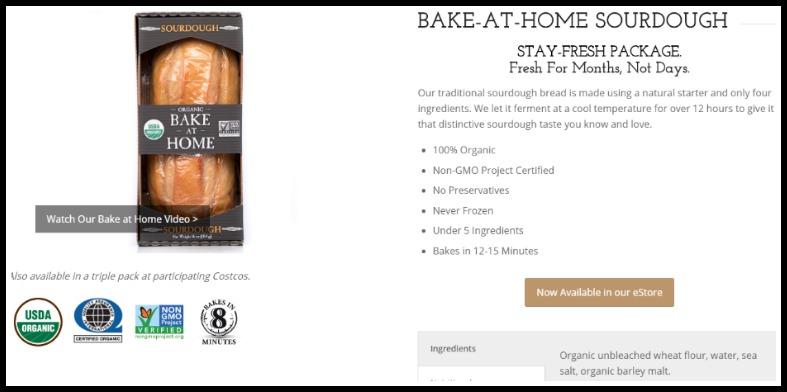
Notice the ingredients say: organic unbleached wheat flour, water, sea salt, organic barley malt.
To semi-researched consumers who know enough about sourdough bread to understand that it never contains yeast, this is enough information to fool them and get them to buy.
Take care not to be easily fooled, however! Look what I found when I looked at the actual label of this very same sourdough bread at the store. Check out the photo below taken on the very same date – December 28, 2016.
The exact same sourdough bread has YEAST listed on the box!
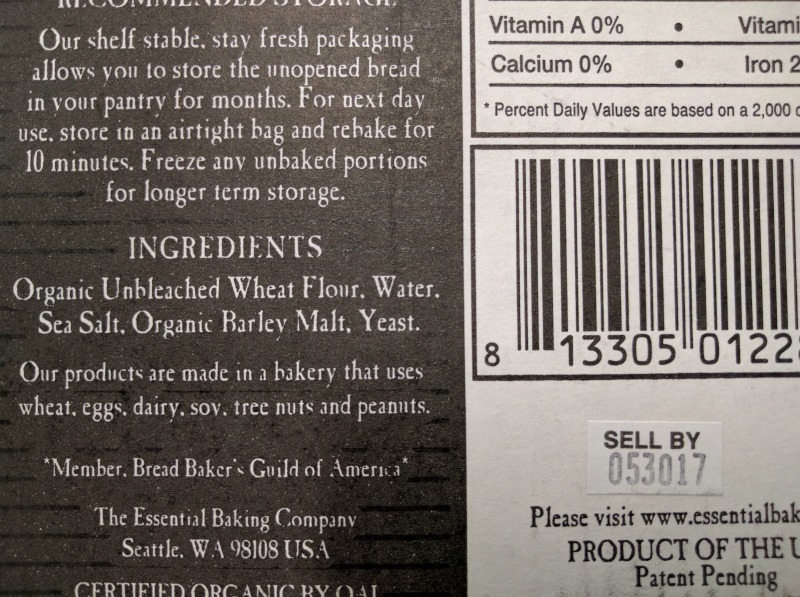
This is a new tactic I have not been aware of before … listing different ingredients for a product online versus what is on the label. Online it states “under five ingredients” using a “natural starter” with the bread “fermented” at a cool temperature for over 12 hours. The box at the store, however, lists 5 ingredients and the “natural starter” turns out to be yeast, which is most decidedly unnatural when it comes to sourdough! Other problems with this bread include the use of sweetener (organic barley malt) and white flour.
If a product seems too good to be true, it probably is.
I mean, seriously? Would an authentic sourdough come in a convenient “bake at home in 12-15 minutes” package that is shelf-stable for nearly 6 months?
Absolutely not!
The short video below summarizes the issues and how to spot the good stuff.
Authentic Labels
The label of true sourdough bread is going to list sourdough starter instead of yeast in the list of ingredients. For example, the gluten-free sourdough bread I buy from a local bakery has “cultured brown rice flour” listed as the starter.
The wording for the sourdough starter varies from brand to brand.
However, there will usually be some indication of a cultured starter as the leavening agent.
This starter contains natural beneficial yeasts from the environment rather than processed baker’s yeast which increases baking speed and baking temperature.
This is important because naturally leavened bread is more digestible, nutritious and less likely to trigger allergy problems than modern, yeast rise bread.
Ultimately, the consumer really must take the time to ensure that the sourdough bread of their choosing really is what it claims.
The Sourdough Bread I Buy
Real sourdough bread is so difficult to find that I’ve resorted to shipping freshly baked sourdough direct from the bakery to my door.
The bakery I use is Organic Bread of Heaven and I order the Rustic Sourdough. I ship in six loaves at a time and freeze what I won’t use in 4-5 days. They also have sourdough bagels, tortillas, hamburger buns, and English muffins among other authentic items.
Free shipping is available for orders over $49 (ask a friend to jump in with you!). The price is several dollars cheaper per loaf than the bread at the health food store.
To give it a try, use coupon HEALTHYHOME (all caps) for 10% off your first order.
Even if you pay shipping by ordering just a few real sourdough loaves, the price per loaf is still comparable to the fake sourdough at the health food store!
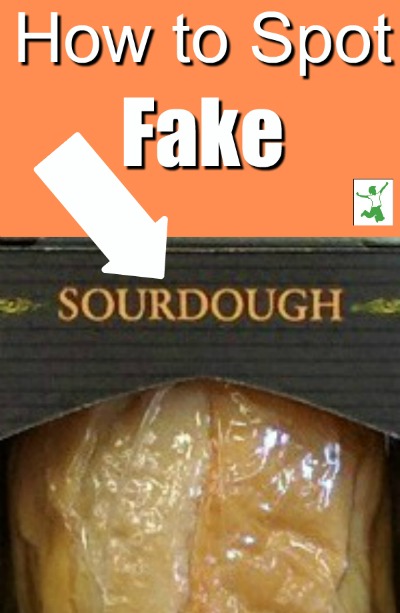
Rules of Thumb
Here are some rules of thumb to identify authentic sourdough bread:
- A handful of ingredients
- No yeast
- Cultured flour starter
- No sweetener
- Made using whole grain flour
- The dough ferments before baking for at least 4-6 hours
After examining the label, if you are still unsure, make a phone call or email to the company. Ask how long the sourdough is allowed to rise (double in size) before baking.
A true sourdough is going to rise for a minimum of about 4-6 hours and even as long as 10-15 hours depending on the temperature.
No baker’s yeast is needed. In addition, no sweetener should appear on the label.
Fake Sourdough At Panera
Be aware that Panera markets its sourdough as real when it is fake too.
Longtime reader Beth S. sent me this email from Panera customer support when she inquired about the authenticity of its sourdough bread. Beth gave her permission to reprint this email.
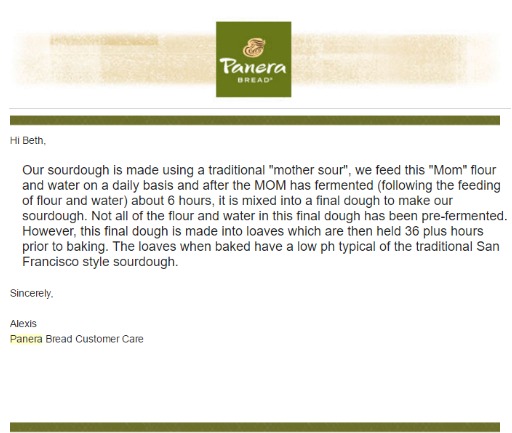
While this answer sounds promising, examining the ingredients of Panera Bread’s sourdough quickly identifies it as a fake. From the Panera website:
Unbleached Enriched Wheat Flour (Flour, Malted Barley Flour, Niacin, Reduced Iron, Thiamine Mononitrate, Riboflavin, [synthetic] Folic Acid), Water, Salt, Yeast (Yeast, Sorbitan Monostearate, Ascorbic Acid [GMO]), Dough Conditioner (Ascorbic Acid [GMO], Microcrystalline Cellulose [refined wood pulp], Corn Starch [GMO])
Not only is the Panera sourdough a phony, but it also contains yeast, wood pulp, and GMOs. It is also fortified with synthetic vitamins including dangerous folic acid (instead of natural folate).
At least The Essential Baking Company’s fake sourdough described earlier in this article is organic. This means no GMOs or other toxic ingredients.
As you can see, the phony sourdoughs on the market today range from simply misleading to downright dangerous. Best to avoid them all and get the real thing!
Do you currently buy an authentic sourdough? If so, what are the ingredients and what is the brand?








I just bought the worst sourdough from Panera. Wish I had read this first. It tastes like cheap white bread. Taking it back.
Hi Sarah,
I am the marketing manager at The Essential Baking Company and just discovered this article today because a consumer emailed us the link. We were in shock to learn about the the things that were being said about our Bake-at-Home line, but realize that our packaging is a bit misleading.
We pride ourselves in creating hand-formed artisan bread using all-natural starters and time-honored techniques. This means, not adding any commercial yeast.
Our Bake-at-Home line currently has overstated ingredients on the packaging. It does NOT contain yeast.
We recently added “yeast” to the ingredients statement on the package in case we needed to supplement our existing formula due to temperature fluctuations in the bakery this winter (It makes the yeast rise and behave differently, sometimes causing bubbling and holes).
We have been able to continue baking our breads with only natural starters and naturally occurring yeast, so there is not added Yeast in our bread. We will be removing it as an ingredient on our packaging in the next print run! We apologize for the confusion and regret the decision to overstate.
Also check the label for citric acid (sour salt). While this is a natural, perfectly harmless ingredient, it’s used to make the bread more sour tasting. I’ll admit that I use it in my sourdough that I make at home (from Carl Griffith’s 1800s starter). My bread is authentic sourdough using no commercial yeast, but I do love the extra “tang” that sour salt gives it! :/ But some bakeries add it to regular old yeasted bread and call it sourdough!
Another ‘indicator’ that you are not buying true sourdough is when the label lists vinegar. This is a common ingredient in conventional grocery store ‘sourdough breads’ but even some ‘health foods’ type stores carry this sort of bread. Indeed, in S.E. Idaho, there are no ‘health food’ stores that carry any brand of true sourdough.
Thanks Sarah for another awesome article! When I have a health or food question, your blog is one of the first places I visit. I agree that most commercial sourdough bread are taking shortcuts but I’m not convinced that added yeasts is bad because a sourdough culture is yeast.. I believe it could be a good thing if used correctly. Below is my math and logic:
Plain bread or grass seeds have 4ish digestibility factors:
Active anti-nutrients in unsprouted seeds
Soaking/Sprouting/germinating then cooking deactivate most of these anti-nutrients. Animals with twice the digestive hardware of humans sprout their nuts and seeds. Other animals have specific organs that sprout seeds.
Fiber or Cellulose (Long chains of indigestible glucose)
Cellulose is extremely difficult to digest even for cows. Herbivores evolved to digest cellulose and have much much more digestive organ mass than we do. Cellulase the enzyme that breaks down cellulose isn’t produced by the cow but by the cow’s bacteria. Cellulose is broken down by grinding seeds into grain, fermenation and cooking. Weston A. Price himself has a great article somewhere about the danger of high fiber foods not prepared correctly.
Starch (Long chains of glucose)
Fermentation and cooking breaks down starch. If you have candida this will feed them. Candida needs to be addressed with herbal antifungals and immune system support.
Proteins (Long chains of amino acids)
Gluten doesn’t cause issues with bread. Its the anti nutrients from unsprouted seeds and candida in the body. Fermentation and cooking makes protein easier to digest.
Sprouting/germinated/soaking is the most important step in the bread making process.
This deactivates most of the anti-nutrients.
All life forms struggle with the anti nutrients found in unsprouted seeds, including yeasts.
Beer brewers will malt(which involves germinating) their grains before adding yeasts to the brew.
They do this so the brew will ferment much faster.
The sourdough process breaks down starch, cellulose and protein requiring less work for digestion. The longer the fermentation the more broken down these macronutrients are.
A sourdough starter/culture is yeast of good quality. They are almost the same thing.
Bakers yeast that rises bread is pretty bad but there are a bunch of cool wild and nutritional yeasts on the market.
The questions to ask are:
Is the flour from sprouted/soaked/germinated grass seeds?
What kind of starter is used?
How long did dough ferment?
Let’s look to how our ancestor did it:
How did the Swiss in Weston A. Price’s book make bread? It doesn’t really say in the book. But I have heard Sally Fallon mention they did way more than just sourdough it.
I have bought this on occasion and the first time it definitely did not have yeast on the label- I just checked the box on the latest purchase and it now says yeast- total bait and switch!
Food manufacturers do this … they know consumers will check the label at first .. then decide to buy … then rarely check it again. You really have to keep checking AND check on the website.
This is how the Big Food companies make huge profits when they buy out little organic companies that have built a consumer base that trusts their products. They keep the quality ingredients the same for a year or two after the buy-out, then slowly cheapen the ingredients and most consumers never figure it out.
I’ve been buying this bread from Costco, and my box definitely does not have “yeast” labeled in the ingredients, just the 5 ingredients they list on their website. Now I’m confused…
If you check the bread on the website, it says yeast. Bait and switch I’m afraid is what it looks like! The boxes at my store definitely say “yeast” in the ingredients as you can see from the photo in the post.
Sourdough millet/quinoa fermented bread from grindstonebakery.com ships anywhere. INGREDIENTS: Whole quinoa* and whole millet* stone-ground at the bakery, purified water, psyllium husks*, fermentation starter (quinoa*, millet*, purified water), Nana Mae’s Apple Juice* (not from concentrate), sea salt. Isn’t cheap, $10.95. Ship every Tues. and you must buy at least 4 items for ease of shipping. They have other products all made same way. Toasted with Manuka honey it is quite good. I get mine and slice it, then put in freezer or frig and it lasts more than a month.
I’ve been making my own sourdough bread for several years now, and it tastes great. However, my recipe calls for unbleached flour and also includes a tablespoon of sugar, although I use raw honey.
From your article, I infer that my bread is not really sourdough, although I use no yeast and the rising process can take anywhere from 8 hours to overnight.
Thick crust, moist inside, lovely sour aroma and flavor. What am I baking? Serious question.
Thanks.
You are baking a modified sourdough. I would also recommend never cooking or baking with honey. https://www.thehealthyhomeeconomist.com/is-cooking-honey-unhealthy/
Here’s more on the myths about sourdough bread: https://www.thehealthyhomeeconomist.com/sourdough-bread-myths/
This article seems to be based on the authors misunderstanding of the role of yeast in sourdough bread fermentation. She also seems to be generally misinformed about the use of “white” flour contributing to “fake” sourdough.
Sourdough bread is the result of yeast and Lactic acid producing bacteria working in symbiosis.
Whether this is a natural occurring yeast, as in traditional San Francisco or Alaskan sourdough starters or from a commercially produced yeast is another discussion.
Sourdough bread is formed by long fermentation to produce CO2, organic acids (lactic and acetic) and alcohol (ethanol) which are byproducts of the fermentation process. These byproducts are the souring agents that give sourdough its characteristic taste and contribute to longer keeping properties.
Pre-ferments and traditional starters are just a way of introducing the fermentation cultures to the bulk dry ingredients to form a dough. Whether the ingredient panel includes yeast as an ingredient or not you can rest assured that yeast was responsible for the fermentation.
Other bacterial cultures may be present and contribute to the fermentation and flavor profiles of the finished bread.
If you are truly on the lookout for “fake” sourdough stay away from brands which display the following ingredients found on the label of a national brand Authentic Sourdough:
Corn Syrup High Fructose, Dough Conditioners (Contains One Or More Of The Following, Sodium Stearoyl Lactylate, Mono and Diglycerides, Enzymes, Ascorbic Acid, Azodicarbonamide ), Yeast Nutrients ( Monocalcium Phosphate, Calcium Sulphate, Ammonium Sulfate ), Fumaric Acid, Lactic Acid, Dextrose, Calcium Propionate (Preservative), Corn Starch, Soy Flour
There are some types of specialty diet breads that rely on other agents for leavening such as baking soda, baking powder, etc…
I would suggest re-reading the article!